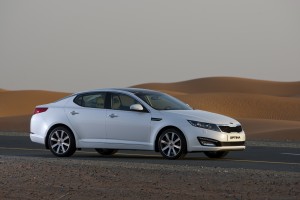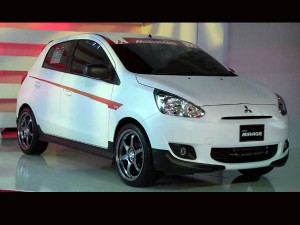A close look at new model launches at PIMS
Kia optimizes the sedan
Kia has been on a roll. It has been capitalizing on its main assets: the engineering support of parent company Hyundai, and the styling capabilities of erstwhile Audi designer Peter Schreyer.
Embodying Kia’s bold new direction is its stunning new Optima sedan. Looking like a British luxury sedan, the Optima is a D-segment sedan that aims to give Kia and Philippine distributor Columbian Autocar Corp. a toehold in the lucrative executive sedan market.
“The next-generation Optima possesses the power to surprise. It’s a car that people will simply not expect from Kia—and that’s exactly what we set out to achieve,” Schreyer said.
The Optima features a raked roofline, shallow greenhouse, and elongated body structure: all elements of a design that is arguably the best-looking in the class, and it can even give European car a run for their euro.
The cab-rearwards styling cues feature a chrome arc flowing from A to C pillar, making the car look lower to the ground. Inside, the Optima is as spacious as its Japanese rivals, with premium materials and equipment.
Article continues after this advertisementEven with those features, the Optima is projected to continue Kia’s value-for-money proposition, coming in at a price lower than most of its competition.
Article continues after this advertisement
Mitsubishi reenters the subcompact race with all-new Mirage
The all-new Mitsubishi Mirage has been on the horizon for quite some time, and now its launch date is getting nearer. The Mirage is the all-new edition of Mitsubishi’s compact car. The
nameplate was used for what we know here as the Lancer in the US market. We have always associated it with a subcompact hatchback.
It was a subcompact hatchback that made its debut at the last Tokyo Motor Show bearing the Mirage name. The new car checks in a compact 3.71 meters long, 1.665 meters side, and 1.49 meters tall. Despite the compact footprint, Mitsubishi says that the car is designed to comfortably seat five. Turning radius is a measly 4.4 meters. Front-end visibility is reportedly among the best in its class.
The interior features a flat dashboard to improve spaciousness. An available eco-assist display in the instrument cluster helps the driver monitor his fuel efficiency and drive accordingly. Practicality is aided by the 60/40 split-fold seats.
The car is designed primarily for efficiency, making it a participant in Thailand’s eco-car program, as well as making it popular in its native Japan. With hybrids immensely popular in the homeland with its very expensive gasoline, the Mirage is designed to approach the efficiency of a hybrid with a conventional internal-combustion drivetrain.
The Mirage uses a 1.0-liter, 3-cylinder engine with the company’s MIVEC variable valve timing control system. Output is 68 hp and 86 Nm. The engine is also equipped with auto stop and go and a regenerative braking system. The drivetrain uses a continuously variable transmission. Electric power steering helps the fuel efficiency. Even the tires, in size 165/65 R 14, are low rolling resistance models.
The new hatchback is a global car developed, according to Mitsubishi, with positioning as both an entry-level car and an eco-car in so-called advanced markets. The car has already received 33,000 orders in Thailand, and 5,000 units in Japan. Fuel efficiency according to company data ranges from 23.2 kpl to 27.2 kpl for car equipped with such functions as the auto start-stop, the highest of any gasoline car in Japan.
With a projected low price point in the range of P500,000 the new Mirage is set to give its Korean, Japanese, and Chinese competitors a run for their money.
Nissan’s hidden gems: 370Z and Juke
It’s no secret that Nissan has some of the best cars on the market right now—in other countries. Never mind more exotic offerings like the GT-R and the Infiniti luxury lineup (for now). Two of the company’s humbler models would slot right in to the company’s Philippine portfolio and rapidly expand its fan/customer base.
With the current renaissance in sports cars, with the Hyundai Genesis Coupe, Ford Mustang, Subaru BRZ and even hyper-conservative Toyota launching the Subaru-engineered 86, the time is ripe to introduce Nissan’s Z car. The 370Z, like the BRZ and 86, is similarly compact and dripping with taut style. The styling trades on decades of heritage while still being thoroughly modern.
At the heart of the Z is a high-performance 3.7-liter dohc V6 engine, with standard 332 hp. The engine is mated to a choice of a six-speed manual transmission or a seven-speed automatic.
The exterior is unmistakably linked to the original Fairlady/240Z, a highly-aerodynamic shape with a long hood and sharply sloping rear section. To save on weight and to lower the center of gravity, the car features aluminum door panels, hood and hatch. The chassis is reinforced front and rear, with an underbody V-bar and a carbon fiber composite radiator housing. Nissan started a trend with the boomerang-shaped headlamps of the 370Z, housing HID bi-xenon headlamps with auto on/off and LED daytime running lights. The shape is echoed in the rear, which also has arrow-shaped lights flanking the wide rear fenders. The styling has passed through a rigorous wind-tunnel program, resulting in zero front lift and zero rear lift when equipped with a rear spoiler.
The available seven-speed transmission features downshift rev matching and quick shifts when operated in manual mode, via the paddle shifters or the shift lever. Double-wishbone front suspension and multi-link rear suspension offer responsive handling. 18-inch tires are standard, with optional 19-inch package.
Nissan Motor Philippines launched the 350Z a few years ago, then let the car quietly disappear from its lineup. We say it’s high time it comes back to stay.
On the more practical side, Nissan has also given the compact crossover a shot in the arm with its radical-looking Juke. Looking nothing like the other offerings in this segment, the Juke looks like a cross between the Patrol and the Batmobile. It has a highly unusual front lamp design, with the enormous foglamps in the bumper and the blister-like headlamps flanking the hood. The hidden rear doors open up to an interior good for five adults.
The Juke features a 1.6-liter direct-injection turbocharged gasoline engine, good for 188 hp. The power goes through a torque-vectoring all-wheel drive system, which directs torque to the corner needing it most. Juke reportedly boasts of a sporty driving position, responsive handling, with the unlikely combination of SUV aspects like raised ground height and all-wheel drive. A six-speed manual and Nissan’s Xtronic CVT are the available transmissions.
The Juke has been a bit of an image leader for Nissan, with the company creating a Juke-R version, an even more dastardly combination of the running gear of the GT-R and a Juke body. The Juke-R has been received with great anticipation, such that Nissan is building the Juke-R to order, in limited quantities.
Even if Nissan added just two vehicles to its lineup—370Z and Juke—it would do the company image and sales a world of good. Then it can consider launching the other unique vehicles in its stable, such as the electric Leaf and the boxy Cube.
A lot to expect from Suzuki’s Swift Sport
The Suzuki Swift has been a successful offering from the Japanese company, combining rakish good looks (not unlike a certain British hatchback) and zippy performance that is in line with its name. Now, no matter what level one is starting on, no performance is quite enough, so Suzuki has seen fit to upgrade the capabilities of the Swift with a bump in engine specifications as well as numerous other improvements. This gives rise to the new Swift Sport; Suzuki Philippines recently previewed the new model.
Swift Sport features a new Euro 5 certified 1.6-liter engine with variable valve timing, good for 136 hp and 160 Nm, certainly generous for a car of the Swift Sport’s size. The engine is mated to a standard six-speed manual transmission, to maximize its propulsive power. This is good for a 0-100 kph time of 8.7 seconds, and a maximum speed of 193 kph.
Exterior design upgrades include aero parts exclusive to the model; these help suppress lift and make the car more aerodynamically efficient, as well heat up the car’s looks by several degrees. The interior features sport seats with more upscale fabric. A five-meter cluster provides easy monitoring of all vehicle functions.
Standard equipment is potentially generous, with auto climate control, fog lamps, push button start, Bluetooth connectivity, HID headlamps, rear privacy glass, and cruise control. ESP stability control and seven airbags are standard for better safety.
The Swift Sport also offers higher levels of steering and braking performance from the standard Swift hatchback. The new car features greater toe and camber rigidity for its torsion beam suspension, as well as more rigid bushings and larger wheel bearings. These are fitted to enhance stability and cornering. Front and rear coil springs feature increased spring rates and the addition of rebound springs in the front suspension struts, to greatly increase roll stiffness.
The increase in performance comes with a welcome benefit of better mileage and a cut in emissions: both are improved by 10 percent from the previous Swift Sport.
The Swift Sport will be a welcome addition to Suzuki Philippines’ expanding lineup.


